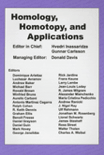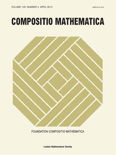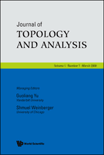
Homology Homotopy and Applications
Scope & Guideline
Unlocking New Dimensions in Mathematical Sciences
Introduction
Aims and Scopes
- Homotopy Theory:
Research in this area explores the properties and applications of homotopy theory, including the study of homotopy types, homotopy categories, and spectral sequences. - Algebraic Topology:
This encompasses studies on various algebraic invariants of topological spaces, analyzing their relationships and implications in both pure and applied contexts. - Category Theory and Higher Structures:
The journal features work on higher category theory, including derived categories, model categories, and their applications in homotopy theory. - Configuration Spaces and Their Applications:
Significant contributions involve the study of configuration spaces, particularly their homological properties and applications in algebraic topology. - Cohomology Theories:
The journal publishes research on various cohomology theories, including singular, sheaf, and persistent cohomology, often focusing on their applications in different mathematical contexts. - Operads and Algebraic Structures:
Research involving operads and their applications to algebraic topology and homotopy theory is a key focus, providing insights into the structure of algebraic operations.
Trending and Emerging
- Persistent Homology and Applications:
There has been a marked increase in publications related to persistent homology, particularly in its applications to data analysis and topological data science, reflecting the growing interdisciplinary nature of the field. - Interactions Between Algebra and Topology:
Recent papers highlight a trend towards exploring deeper connections between algebraic structures and topological properties, particularly through the lens of derived and categorical methods. - Higher Category Theory:
The rise of interest in higher category theory and its applications in homotopy theory is evident, with an increasing number of papers addressing this complex and abstract area. - Operadic Structures:
Research on operads and their applications in various mathematical contexts is emerging, indicating a growing recognition of their significance in understanding algebraic and topological phenomena. - Applications of Homotopy Theory in Other Disciplines:
There is an increasing trend towards exploring the applications of homotopy theory in fields outside of pure mathematics, including physics and computer science, which may broaden the journal's audience.
Declining or Waning
- Classical Algebraic Topology:
There seems to be a declining emphasis on traditional results and methods in classical algebraic topology, with more focus shifting towards modern and abstract approaches. - Geometric Group Theory:
Recent publications suggest a waning interest in geometric group theory topics, potentially as the field evolves towards more algebraic or topological frameworks. - Topological Field Theories:
While once a vibrant area of research within the journal, the frequency of papers on topological field theories has decreased, possibly indicating a shift towards other mathematical frameworks. - Homotopical Algebra without Higher Structures:
Research papers focusing strictly on homotopical algebra methods without higher categorical considerations have become less frequent, which may reflect an increased complexity and abstraction in ongoing research.
Similar Journals

APPLIED CATEGORICAL STRUCTURES
Connecting Scholars Through Groundbreaking ResearchApplied Categorical Structures is a prominent journal published by Springer, dedicated to the dissemination of high-quality research in the intersecting domains of algebra, number theory, and theoretical computer science. Since its inception in 1993, this journal has fostered academic discussion and innovation, contributing significantly to the advancement of categorical methodologies in these fields. With an impressive 2023 Q2 ranking in both Algebra and Number Theory, and Computer Science categories, it reflects a strong standing in the scientific community, positioning itself as a valuable resource for scholars. The absence of an Open Access model allows for a traditional subscription-based distribution, providing readers with curated, peer-reviewed articles that ensure academic integrity. Aspiring authors and researchers are encouraged to publish their work here, where their contributions will resonate across a vibrant network of professionals prioritizing cutting-edge development in categorical theory and its applications.

Kyoto Journal of Mathematics
Bridging gaps in knowledge with premier mathematical insights.Kyoto Journal of Mathematics is a premier academic publication dedicated to advancing the field of mathematics, published by DUKE UNIVERSITY PRESS. Established in 1996, this journal serves as a vital platform for sharing innovative research and breakthrough studies across various mathematical disciplines. The journal has consistently maintained a prestigious Q1 ranking in the category of Mathematics (miscellaneous) as of 2023, reflecting its significant impact and contribution to the mathematical community. With its Open Access policy, the Kyoto Journal of Mathematics ensures that groundbreaking research is easily accessible to a global audience, fostering collaboration and knowledge dissemination among researchers, professionals, and students alike. The journal's commitment to excellence and relevance in mathematical research is underscored by its extensive archive of published works and its continuous engagement with contemporary mathematical challenges. This makes the journal an essential resource for anyone seeking to stay abreast of current trends and advancements in the field.

Categories and General Algebraic Structures with Applications
Unlocking the Power of Categories and StructuresCategories and General Algebraic Structures with Applications is a pivotal open-access journal dedicated to advancing the field of mathematical sciences, particularly focusing on categories, algebraic structures, and their diverse applications. Published by Shahid Beheshti University, Faculty of Mathematical Sciences, this journal has established itself as a significant resource since its inception in 2013, providing a platform for the dissemination of innovative research. With its ISSN: 2345-5853 and E-ISSN: 2345-5861, the journal spans a wide array of topics essential for researchers in Analysis, Applied Mathematics, Computational Mathematics, and Discrete Mathematics and Combinatorics, having achieved respectable ranks across these categories in Scopus with notable quartiles. The journal aims to foster interdisciplinary collaboration and knowledge exchange among mathematicians and practitioners, making it a vital tool for those seeking to contribute to or stay informed about contemporary developments in mathematical research and applications. With a convergence period from 2017 to 2024, it continues to prioritize high-quality research outputs advantageous for both academia and industry.

MANUSCRIPTA MATHEMATICA
Pioneering Insights in Diverse Mathematical Disciplines.MANUSCRIPTA MATHEMATICA is an esteemed journal in the field of mathematics, published by Springer Heidelberg. Since its inception in 1969, this journal has served as a pivotal platform for disseminating high-quality research in a variety of mathematical disciplines, with a commitment to advancing knowledge and fostering collaboration among mathematicians. The journal holds a commendable impact factor and is ranked within the Q2 category for Mathematics (miscellaneous) in 2023, placing it favorably among its peers in terms of academic influence. Although open access options are not available, its rigorous peer-review process ensures that published articles maintain the highest academic standards. With a wide scope covering significant areas of general mathematics, MANUSCRIPTA MATHEMATICA not only caters to researchers and professionals seeking innovative insights but also serves as a valuable resource for students eager to deepen their understanding of mathematical theories and applications. For those looking to contribute to or stay informed about advancements in this dynamic field, the journal remains a crucial resource for literature and discourse.

Archivum Mathematicum
Bridging Theory and Practice in MathematicsArchivum Mathematicum is an open-access journal dedicated to the broad spectrum of Mathematics, published by Masaryk University, Faculty of Science in the Czech Republic. Since its inception in 1965, this journal has provided a platform for the dissemination of research and advancements within the mathematical sciences. It spans converged years from 2004 to 2024, ensuring ongoing relevance in a rapidly evolving discipline. Currently categorized in Q4 for 'Mathematics (miscellaneous)' and ranked #316/399 in general mathematics by Scopus, the journal aims to foster a collaborative environment for researchers, practitioners, and students alike, encouraging submissions that contribute to mathematical theory, applications, and education. With its commitment to open access, Archivum Mathematicum is a vital resource for anyone seeking to stay informed about emerging trends and findings in the field.

COMPOSITIO MATHEMATICA
Exploring the Depths of Algebra and Number TheoryCOMPOSITIO MATHEMATICA, published by Cambridge University Press, is a leading journal in the field of mathematics, with a specific focus on algebra and number theory. With an impressive impact factor and ranked in the Q1 quartile for its category, it holds a prominent position in the academic landscape, currently standing at Rank #26 out of 119 journals in its field, within the 78th percentile of its category, according to Scopus rankings. Since its inception in 1996, the journal has been dedicated to publishing high-quality research articles that contribute significantly to the advancement of mathematical knowledge and theory. While it does not offer open access, the journal ensures a rigorous peer-review process that upholds the highest academic standards. Researchers, professionals, and students alike are encouraged to engage with the rich, innovative content of COMPOSITIO MATHEMATICA, which continues to foster a vibrant scholarly community dedicated to exploration and discovery in mathematics.

Publications Mathematiques de l IHES
Advancing mathematical frontiers since 1959.Publications Mathematiques de l IHES, published by SPRINGER HEIDELBERG, stands as a premier journal in the field of mathematics, particularly renowned for its contributions to general mathematics and related disciplines. With a distinguished ranking of 7 out of 399 in Scopus and a remarkable position within the 98th percentile, this journal underscores its significance in disseminating high-quality mathematical research. Active since 1959 and continuing through to 2024, the journal has established itself as a vital platform for scholars, providing rich insights and advancements in theoretical and applied mathematics. Despite being a non-open access journal, its exclusive collections remain widely respected in academia, particularly within Q1 quartile rankings in Mathematics (miscellaneous). With comprehensive and rigorous peer-reviewed articles, Publications Mathematiques de l IHES is essential reading for researchers, professionals, and students eager to engage with cutting-edge mathematical developments.

Journal of Topology and Analysis
Illuminating the Intersections of Topology and AnalysisJournal of Topology and Analysis, published by WORLD SCIENTIFIC PUBL CO PTE LTD, is a distinguished peer-reviewed journal that focuses on advanced topics in mathematics, specifically within the fields of topology and analysis. Established in 2009 and running through 2024, the journal is based in Singapore and strives to present cutting-edge research that contributes to the mathematical community's understanding of geometric structures and analytical theories. Holding a respected position with a Q2 ranking in Analysis and a Q3 ranking in Geometry and Topology according to the 2023 category quartiles, the journal is indexed in Scopus, where it ranks #49 in Geometry and Topology and #118 in Analysis, showcasing its significance in the scholarly landscape. The Journal of Topology and Analysis aims to foster interdisciplinary collaboration by providing a platform for researchers, professionals, and students to share innovative findings and insights. Although it does not currently offer open access, its contributions are vital for advancing knowledge in these mathematical domains.

JOURNAL OF ALGEBRA AND ITS APPLICATIONS
Bridging the Gap Between Algebraic Theory and ApplicationJOURNAL OF ALGEBRA AND ITS APPLICATIONS, published by WORLD SCIENTIFIC PUBL CO PTE LTD, stands as a pivotal resource for scholars in the fields of Algebra and Applied Mathematics. With an ISSN of 0219-4988 and E-ISSN 1793-6829, this journal has been providing a forum for the dissemination of cutting-edge research since its inception in 2008, converging towards a forward-looking timeline extending to 2024. As of 2023, it has earned a commendable Q2 ranking in both Algebra and Number Theory, as well as Applied Mathematics, reflecting its solid impact within the mathematical community. With a Scopus rank of #49/119 in Algebra and Number Theory, and #420/635 in Applied Mathematics, the journal captures significant advancements and applications across various mathematical domains. While it does not operate under an open access model, its comprehensive articles and research outputs are crucial for fostering intellectual dialogue and innovation in academia. Researchers, professionals, and students alike will find this journal an indispensable asset for their scientific pursuits and explorations into the vast field of mathematics.

Forum of Mathematics Sigma
Innovative research, limitless possibilities.Forum of Mathematics Sigma is a premier open access journal published by Cambridge University Press that has been at the forefront of mathematical research since its inception in 2013. With a strong emphasis on advancing the fields of mathematics, the journal consistently achieves Q1 rankings across multiple categories, including Algebra and Number Theory, Analysis, and Computational Mathematics. This distinction highlights its impact and relevance within the scholarly community. The journal prides itself on providing a platform for innovative research, fostering collaboration among researchers and practitioners across various mathematical disciplines. Open access publication ensures that cutting-edge findings are widely available to readers globally, enhancing the dissemination of knowledge. With an address in the heart of Cambridge, England, Forum of Mathematics Sigma is dedicated to promoting high-quality research and making significant contributions to the development of mathematics.